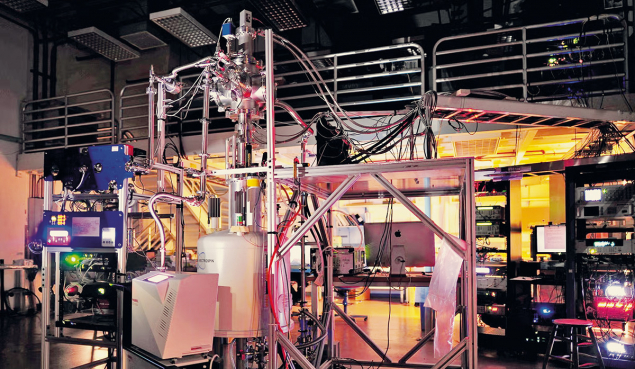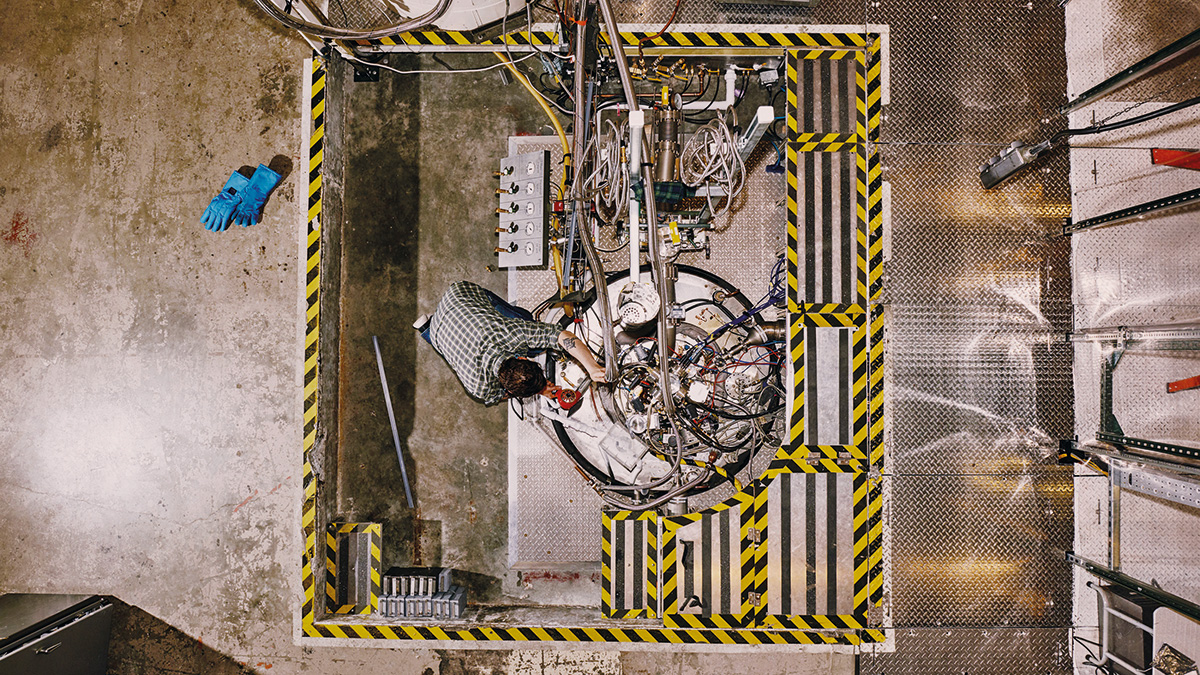Quantum sensors have become important tools in low-energy particle physics. Michael Doser explores opportunities to exploit their unparalleled precision at higher energies.
Atomic energy levels. Spin orientations in a magnetic field. Resonant modes in cryogenic, high-quality-factor radio-frequency cavities. The transition from superconducting to normal conducting, triggered by the absorption of a single infrared photon. These are all simple yet exquisitely sensitive quantum systems with discrete energy levels. Each can serve as the foundation for a quantum sensor – instruments that detect single photons, measure individual spins or record otherwise imperceptible energy shifts.
Over the past two decades, quantum sensors have taken on leading roles in the search for ultra-light dark matter and in precision tests of fundamental symmetries. Examples include the use of atomic clocks to probe whether Earth is sweeping through oscillating or topologically structured dark-matter fields, and cryogenic detectors to search for electric dipole moments – subtle signatures that could reveal new sources of CP violation. These areas have seen rapid progress, as challenges related to detector size, noise, sensitivity and complexity have been steadily overcome, opening new phase space in which to search for physics beyond the Standard Model. Could high-energy particle physics benefit next?
Low-energy particle physics
Most of the current applications of quantum sensors are at low energies, where their intrinsic sensitivity and characteristic energy scales align naturally with the phenomena being probed. For example, within the Project 8 experiment at the University of Washington, superconducting sensors are being developed to tackle a longstanding challenge: to distinguish the tiny mass of the neutrino from zero (see “Quantum-noise limited” image). Inward-looking phased arrays of quantum-noise-limited microwave receivers allow spectroscopy of cyclotron radiation from beta-decay electrons as they spiral in a magnetic field. The shape of the endpoint of the spectrum is sensitive to the mass of the neutrino and such sensors have the potential to be sensitive to neutrino masses as low as 40 meV.

Beyond the Standard Model, superconducting sensors play a central role in the search for dark matter. At the lowest mass scales (peV to meV), experiments search for ultralight bosonic dark-matter candidates such as axions and axion-like particles (ALPs) through excitations of the vacuum field inside high–quality–factor microwave and millimetre-wave cavities (see “Quantum sensitivity” image). In the meV range, light-shining-through-wall experiments aim to reveal brief oscillations into weakly coupled hidden-sector particles such as dark photons or ALPs, and may employ quantum sensors for detecting reappearing photons, depending on the detection strategy. In the MeV to sub-GeV mass range, superconducting sensors are used to detect individual photons and phonons in cryogenic scintillators, enabling sensitivity to dark-matter interactions via electron recoils. At higher masses, reaching into the GeV regime, superfluid helium detectors target nuclear recoils from heavier dark matter particles such as WIMPs.
These technologies also find broad application beyond fundamental physics. For example, in superconducting and other cryogenic sensors, the ability to detect single quanta with high efficiency and ultra-low noise is essential. The same capabilities are the technological foundation of quantum communication.
Raising the temperature
While many superconducting quantum sensors require ultra-low temperatures of a few mK, some spin-based quantum sensors can function at or near room temperature. Spin-based sensors, such as nitrogen-vacancy (NV) centres in diamonds and polarised rubidium atoms, are excellent examples.
NV centres are defects in the diamond lattice where a missing carbon atom – the vacancy – is adjacent to a lattice site where a carbon atom has been replaced by a nitrogen atom. The electronic spin states in NV centres have unique energy levels that can be probed by laser excitation and detection of spin-dependent fluorescence.
Researchers are increasingly exploring how quantum-control techniques can be integrated into high-energy-physics detectors
Rubidium is promising for spin-based sensors because it has unpaired electrons. In the presence of an external magnetic field, its atomic energy levels are split by the Zeeman effect. When optically pumped with laser light, spin-polarised “dark” sublevels – those not excited by the light – become increasingly populated. These aligned spins precess in magnetic fields, forming the basis of atomic magnetometers and other quantum sensors.
Being exquisite magnetometers, both devices make promising detectors for ultralight bosonic dark-matter candidates such as axions. Fermion spins may interact with spatial or temporal gradients of the axion field, leading to tiny oscillating energy shifts. The coupling of axions to gluons could also show up as an oscillating nuclear electric dipole moment. These interactions could manifest as oscillating energy-level shifts in NV centres, or as time-varying NMR-like spin precession signals in the atomic magnetometers.
Large-scale detectors
The situation is completely different in high-energy physics detectors, which require numerous interactions between a particle and a detector. Charged particles cause many ionisation events, and when a neutral particle interacts it produces charged particles that result in similarly numerous ionisations. Even if quantum control were possible within individual units of a massive detector, the number of individual quantum sub-processes to be monitored would exceed the possibilities of any realistic device.
Increasingly, however, researchers are exploring how quantum-control techniques – such as manipulating individual atoms or spins using lasers or microwaves – can be integrated into high-energy-physics detectors. These methods could enhance detector sensitivity, tune detector response or enable entirely new ways of measuring particle properties. While these quantum-enhanced or hybrid detection approaches are still in their early stages, they hold significant promise.
Quantum dots
Quantum dots are nanoscale semiconductor crystals – typically a few nanometres in diameter – that confine charge carriers (electrons and holes) in all three spatial dimensions. This quantum confinement leads to discrete, atom-like energy levels and results in optical and electronic properties that are highly tunable with size, shape and composition. Originally studied for their potential in optoelectronics and biomedical imaging, quantum dots have more recently attracted interest in high-energy physics due to their fast scintillation response, narrow-band emission and tunability. Their emission wavelength can be precisely controlled through nanostructuring, making them promising candidates for engineered detectors with tailored response characteristics.

While their radiation hardness is still under debate and needs to be resolved, engineering their composition, geometry, surface and size can yield very narrow-band (20 nm) emitters across the optical spectrum and into the infrared. Quantum dots such as these could enable the design of a “chromatic calorimeter”: a stack of quantum-dot layers, each tuned to emit at a distinct wavelength; for example red in the first layer, orange in the second and progressing through the visible spectrum to violet. Each layer would absorb higher energy photons quite broadly but emit light in a narrow spectral band. The intensity of each colour would then correspond to the energy absorbed in that layer, while the emission wavelength would encode the position of energy deposition, revealing the shower shape (see “Chromatic calorimetry” figure). Because each layer is optically distinct, hermetic isolation would be unnecessary, reducing the overall material budget.
Rather than improving the energy resolution of existing calorimeters, quantum dots could provide additional information on the shape and development of particle showers if embedded in existing scintillators. Initial simulations and beam tests by CERN’s Quantum Technology Initiative (QTI) support the hypothesis that the spectral intensity of quantum-dot emission can carry information about the energy and species of incident particles. Ongoing work aims to explore their capabilities and limitations.
Beyond calorimetry, quantum dots could be formed within solid semiconductor matrices, such as gallium arsenide, to form a novel class of “photonic trackers”. Scintillation light from electronically tunable quantum dots could be collected by photodetectors integrated directly on top of the same thin semiconductor structure, such as in the DoTPiX concept. Thanks to a highly compact, radiation-tolerant scintillating pixel tracking system with intrinsic signal amplification and minimal material budget, photonic trackers could provide a scintillation-light-based alternative to traditional charge-based particle trackers.
Living on the edge
Low temperatures also offer opportunities at scale – and cryogenic operation is a well-established technique in both high-energy and astroparticle physics, with liquid argon (boiling point 87 K) widely used in time projection chambers and some calorimeters, and some dark-matter experiments using liquid helium (boiling point 4.2 K) to reach even lower temperatures. A range of solid-state detectors, including superconducting sensors, operate effectively at these temperatures and below, and offer significant advantages in sensitivity and energy resolution.

Magnetic microcalorimeters (MMCs) and transition-edge sensors (TESs) operate in the narrow temperature range where a superconducting material undergoes a rapid transition from zero resistance to finite values. When a particle deposits energy in an MMC or TES, it slightly raises the temperature, causing a measurable increase in resistance. Because the transition is extremely steep, even a tiny temperature change leads to a detectable resistance change, allowing precise calorimetry.
Functioning at millikelvin temperatures, TESs provide much higher energy resolution than solid-state detectors made from high-purity germanium crystals, which work by collecting electron–hole pairs created when ionising radiation interacts with the crystal lattice. TESs are increasingly used in high-resolution X-ray spectroscopy of pionic, muonic or antiprotonic atoms, and in photon detection for observational astronomy, despite the technical challenges associated with maintaining ultra-low operating temperatures.
By contrast, superconducting nanowire and microwire single-photon detectors (SNSPDs and SMSPDs) register only a change in state – from superconducting to normal conducting – allowing them to operate at higher temperatures than traditional low-temperature sensors. When made from high–critical-temperature (Tc) superconductors, operation at temperatures as high as 10 K is feasible, while maintaining excellent sensitivity to energy deposited by charged particles and ultrafast switching times on the order of a few picoseconds. Recent advances include the development of large-area devices with up to 400,000 micron-scale pixels (see “Single-photon phase transitions” figure), fabrication of high-Tc SNSPDs and successful beam tests of SMSPDs. These technologies are promising candidates for detecting milli-charged particles – hypothetical particles arising in “hidden sector” extensions of the Standard Model – or for high-rate beam monitoring at future colliders.
Rugged, reliable and reproducible
Quantum sensor-based experiments have vastly expanded the phase space that has been searched for new physics. This is just the beginning of the journey, as larger-scale efforts build on the initial gold rush and new quantum devices are developed, perfected and brought to bear on the many open questions of particle physics.
Partnering with neighbouring fields such as quantum computing, quantum communication and manufacturing is of paramount importance
To fully profit from their potential, a vigorous R&D programme is needed to scale up quantum sensors for future detectors. Ruggedness, reliability and reproducibility are key – as well as establishing “proof of principle” for the numerous imaginative concepts that have already been conceived. Challenges range from access to test infrastructures, to standardised test protocols for fair comparisons. In many cases, the largest challenge is to foster an open exchange of ideas given the numerous local developments that are happening worldwide. Finding a common language to discuss developments in different fields that at first glance may have little in common, builds on a willingness to listen, learn and exchange.
The European Committee for Future Accelerators (ECFA) detector R&D roadmap provides a welcome framework for addressing these challenges collaboratively through the Detector R&D (DRD) collaborations established in 2023 and now coordinated at CERN. Quantum sensors and emerging technologies are covered within the DRD5 collaboration, which ties together 112 institutes worldwide, many of them leaders in their particular field. Only a third stem from the traditional high-energy physics community.
These efforts build on the widespread expertise and enthusiastic efforts at numerous institutes and tie in with the quantum programmes being spearheaded at high-energy-physics research centres, among them CERN’s QTI. Partnering with neighbouring fields such as quantum computing, quantum communication and manufacturing is of paramount importance. The best approach may prove to be “targeted blue-sky research”: a willingness to explore completely novel concepts while keeping their ultimate usefulness for particle physics firmly in mind.
Further reading
C Peña et al. 2025 JINST 20 P03001.
G Hallais et al. 2023 Nucl. Instrum. Methods Phys. Res. A 1047 167906.
B G Oripov et al. 2023 Nature 622 730.
L Gottardi and S Smith 2022 arXiv:2210.06617.
